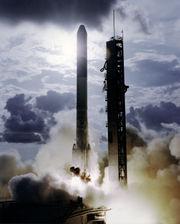
Orbiting Solar Observatory
Encyclopedia


Satellite
In the context of spaceflight, a satellite is an object which has been placed into orbit by human endeavour. Such objects are sometimes called artificial satellites to distinguish them from natural satellites such as the Moon....
s primarily intended to study the Sun
Sun
The Sun is the star at the center of the Solar System. It is almost perfectly spherical and consists of hot plasma interwoven with magnetic fields...
, though they also included important non-solar experiments. Eight were launched successfully by NASA
NASA
The National Aeronautics and Space Administration is the agency of the United States government that is responsible for the nation's civilian space program and for aeronautics and aerospace research...
between 1962 and 1975 using Delta rocket
Delta rocket
Delta is a versatile family of expendable launch systems that has provided space launch capability in the United States since 1960. There have been more than 300 Delta rockets launched, with a 95 percent success rate. Two Delta launch systems – Delta II and Delta IV – are in active use...
s. Their primary mission was to observe an 11-year sun spot cycle in UV
Ultraviolet
Ultraviolet light is electromagnetic radiation with a wavelength shorter than that of visible light, but longer than X-rays, in the range 10 nm to 400 nm, and energies from 3 eV to 124 eV...
and X-ray
X-ray
X-radiation is a form of electromagnetic radiation. X-rays have a wavelength in the range of 0.01 to 10 nanometers, corresponding to frequencies in the range 30 petahertz to 30 exahertz and energies in the range 120 eV to 120 keV. They are shorter in wavelength than UV rays and longer than gamma...
spectra. The initial seven, OSO 1 through OSO 7
OSO 7
OSO 7 is the seventh in the series of American Orbiting Solar Observatory satellites launched by NASA between 1962 and 1975...
, were built by Ball Aerospace
Ball Aerospace
Ball Aerospace & Technologies Corp. is a manufacturer of spacecraft, components, and instruments for national defense, civil space and commercial space applications. The company is a wholly owned subsidiary of Ball Corp...
, then known as Ball Brothers Research Corporation (BBRC), in Boulder Colorado. OSO 8 was built by Hughes Space and Communications Company, in Culver City, California.
The basic design of the entire series featured a rotating section, the "Wheel", which provided gyroscopic stability to the whole. A second section, the "Sail", was driven electrically against the Wheel's rotation, and stabilized to point at the Sun.
The Sail carried pointed solar instruments, and also the array of solar photovoltaic cells which powered the spacecraft.
The critical bearing between the Wheel and the Sail was a major feature of the design, as it had to operate smoothly for months in the hard vacuum of space without normal lubrication. It also carried both the power from the Sail and the data from the pointed solar instruments to the Wheel, where most of the spacecraft functions were located.
Additional science instruments could also be located in the Wheel, generally looking out on a rotating radius vector which scanned the sky, and also across the Sun, every few seconds.
As for a number of other NASA programs, the OSO spacecraft were labeled by letter designations before launch, and only given numbers when successfully placed in orbit.
Thus OSO 1 was originally called OSO A, through OSO I, which became OSO 8. The OSO J was planned but never launched.
See also
- OSO 1
- OSO 2
- OSO 3OSO 3OSO 3, third Orbiting Solar Observatory was launched on March 8, 1967, into a nearly circular orbit of mean altitude 550 km, inclined at 33° to the equatorial plane...
- OSO 4
- OSO 5
- OSO 6
- OSO 7OSO 7OSO 7 is the seventh in the series of American Orbiting Solar Observatory satellites launched by NASA between 1962 and 1975...
- OSO 8
External links
OSO 7, OSO 8 at NASA

